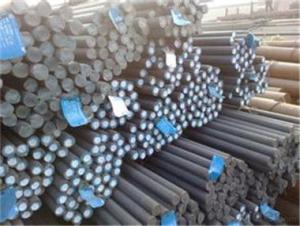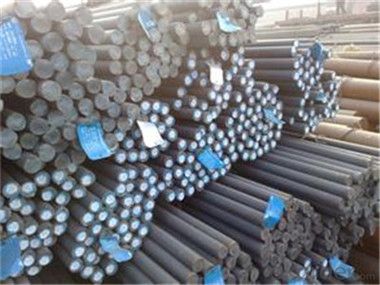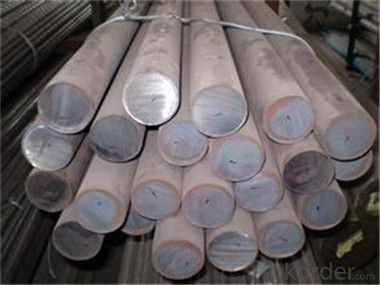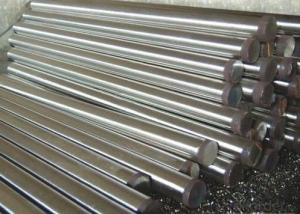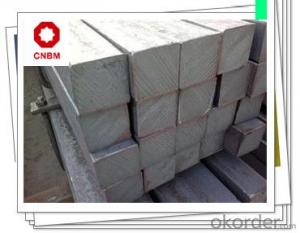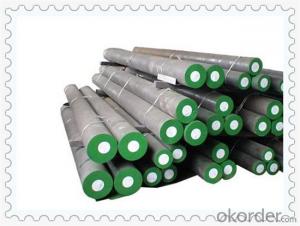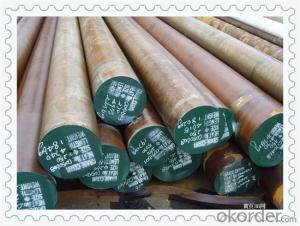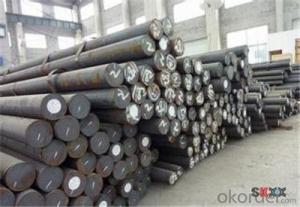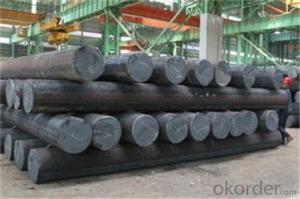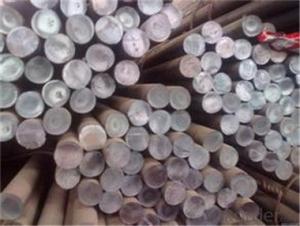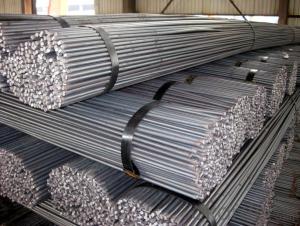Steel Round Bar Reliable Manufacturer from China
- Loading Port:
- Lianyungang
- Payment Terms:
- TT OR LC
- Min Order Qty:
- 221 m.t.
- Supply Capability:
- 200334443 m.t./month
OKorder Service Pledge
OKorder Financial Service
You Might Also Like
Description of steel round bar:
1. Commodity: Round steel bar
3. Technical: Hot rolling
2. Length: Min. 5.8meter, according to requirement.
3. Diameter: 16mm-250mm
5. Packing: In Bundle or according to your requirements.
Festures of steel round bar:
1.Dia 80-800mm Length:2000-13000mm or as required
2.Technique:Forged
3. Annealing after forging:heat to 840-860°c,keep 2-4H,coolbelow to 500°c,hardness≤285HBS. Isothermal annealing after forging:heat to 540-860°c,keep temperature 2-4H,furnacecold to 740-760°c,keep temperature 4-6H,to 500°c,hardness≤255HBS.
Specifications of steel round bar:
1. Standards: AISI 4340 8620 8640 4320 , JIS SNCM8 GB:40CrNiMoA
2. Specification: Dia: 80~450mm Length:2000-13000mm or as required
3. Process: EAF+LF+VD ( necessary) UT+ Peeled +Turned + Heat Treatment (optional)
4. Chemical Composition (%):
C | Si | Mn | S | P | Cr | Ni | Cu | Mo |
0.37-0.44 | 0.17-0.37 | 0.40-0.80 | 0.025(max) | 0.025(max) | 0.60-0.90 | 1.25-1.65 | 0.025(max) | 0.15-0.25 |
Images of steel round bar:
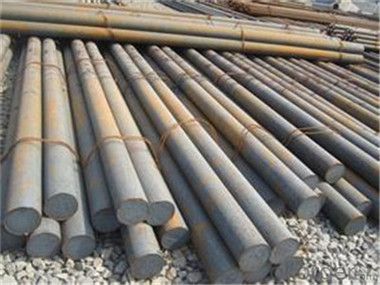
FAQ:
1. What is your package?
Packing situation: standard seaworthy packing or as customer required.
2. How long is the lead time?
Delivery time: 45 days after order confirmed.
3. What payment term do you accept?
Payment: T/T or L/C at sight.
- Q: What are the considerations for selecting the right steel grade for a round bar?
- When selecting the right steel grade for a round bar, there are several considerations to take into account. Firstly, the intended application of the round bar must be evaluated, as different steel grades offer varying levels of strength, hardness, and corrosion resistance. Additionally, factors such as the desired machinability, weldability, and heat treatability should be considered. Furthermore, the environmental conditions in which the round bar will be used, such as temperature and exposure to chemicals, play a crucial role in determining the appropriate steel grade. Lastly, budget constraints and availability of the steel grade should also be taken into consideration. Overall, a thorough analysis of the application requirements and an understanding of the properties of different steel grades are key considerations in selecting the right steel grade for a round bar.
- Q: What are the different types of steel round bars used in the manufacturing of springs?
- There exists a variety of steel round bars that are commonly utilized in the production of springs. These types include: 1. Carbon steel round bars: This particular type of steel is frequently employed for springs and is characterized by its high carbon content, which usually falls within the range of 0.60% to 0.95%. Carbon steel round bars possess commendable strength and durability, rendering them appropriate for a wide array of spring applications. 2. Alloy steel round bars: These are formed by incorporating alloying elements like chromium, manganese, nickel, or vanadium into carbon steel. Alloy steel round bars offer improved mechanical properties, including heightened strength, toughness, and resistance to wear and corrosion. They are commonly employed in demanding or high-performance spring applications. 3. Stainless steel round bars: These bars are resistant to corrosion and contain a significant amount of chromium (usually exceeding 10.5%). Stainless steel round bars are highly sought after for springs that necessitate exceptional resistance to rust, oxidation, and chemicals. They find frequent use in applications where hygiene, cleanliness, and visual appeal are of utmost importance, such as in the food and medical sectors. 4. Spring steel round bars: These bars are specifically designed for spring production. They possess a unique combination of properties, including high yield strength, good fatigue resistance, and excellent elasticity. Spring steel round bars are typically crafted from either carbon steel or alloy steel, depending on the specific requirements of the application. It is crucial to select the appropriate steel round bar based on factors such as the intended application, load requirements, environmental conditions, and desired spring performance. Seeking guidance from a materials engineer or spring manufacturer can aid in determining the most suitable steel round bar for a particular spring manufacturing project.
- Q: How are steel round bars used in the construction of dams and reservoirs?
- Steel round bars are commonly used in the construction of dams and reservoirs for reinforcement purposes. These bars are typically embedded within the concrete structures to enhance their strength and durability. The steel round bars act as a framework, providing structural integrity and preventing cracks or deformations in the concrete. This reinforcement ensures that the dam or reservoir can withstand the immense pressure and load exerted by the water, making them an essential component in the construction process.
- Q: Are steel round bars suitable for machining applications?
- Yes, steel round bars are commonly used in machining applications due to their high strength, durability, and machinability. They can be easily shaped, cut, drilled, and turned into various components, making them suitable for applications in industries such as automotive, aerospace, construction, and manufacturing.
- Q: Cold drawn steel wire is a round bar or thread steel in Construction Engineering?
- Of course it belongs to round bar. Thread steel can not be obtained by cold drawing. Besides, the outer diameter of the cold drawn steel wire is smaller, the surface is smoother and the hardness is slightly higher.
- Q: Can steel round bars be used in the production of machinery?
- Yes, steel round bars can be used in the production of machinery. Steel round bars are commonly used in various industries, including machinery manufacturing. They provide strength, durability, and versatility, making them suitable for applications such as shafts, axles, gears, and other critical components in machinery.
- Q: What are the advantages of using nickel-molybdenum-vanadium alloy steel round bars?
- One advantage of using nickel-molybdenum-vanadium alloy steel round bars is their high strength and toughness. This makes them suitable for applications that require resistance to heavy loads and impact. Additionally, these alloy steel round bars have excellent corrosion resistance properties, making them ideal for use in environments with high humidity or exposure to chemicals. Furthermore, the addition of nickel, molybdenum, and vanadium enhances the material's heat resistance, making it suitable for high-temperature applications.
- Q: What are the different types of steel round bar finishes for decorative purposes?
- There are several different types of steel round bar finishes that are commonly used for decorative purposes. These finishes can enhance the aesthetic appeal and overall look of the steel round bar, making it suitable for various decorative applications. Some of the most popular finishes include: 1. Polished Finish: This is a smooth and shiny finish achieved by polishing the steel round bar using abrasives. It gives a reflective, mirror-like surface that adds a touch of elegance and sophistication to any decorative project. 2. Brushed Finish: Also known as satin finish, this type of finish is achieved by brushing the steel round bar with a fine abrasive material, creating a textured pattern. It provides a slightly matte appearance, making it suitable for contemporary or industrial-style decorative applications. 3. Hammered Finish: This finish involves striking the steel round bar with a hammer, creating a textured and hammered surface. It gives a rustic and aged appearance, making it ideal for decorative items with a vintage or antique-inspired theme. 4. Blackened Finish: This finish is achieved by applying a chemical or heat treatment to the steel round bar, resulting in a darkened or blackened appearance. It adds a sleek and modern touch to decorative projects, making it a popular choice for contemporary designs. 5. Powder Coated Finish: Powder coating is a durable and long-lasting finish where a powdered paint is electrostatically applied to the steel round bar and then cured under heat. This finish allows for a wide range of color options and provides excellent protection against corrosion, making it suitable for both indoor and outdoor decorative applications. These are just a few examples of the different types of steel round bar finishes that can be used for decorative purposes. Choosing the right finish depends on the desired aesthetic, style, and overall theme of the decorative project.
- Q: What are the advantages of using copper-alloy steel round bars?
- There are several advantages to using copper-alloy steel round bars. Firstly, the copper content in the alloy enhances the material's corrosion resistance, making it suitable for applications in harsh environments or exposed to moisture. Secondly, the combination of copper and steel results in improved strength and durability, allowing the round bars to withstand heavy loads and high-stress conditions. Additionally, copper-alloy steel round bars offer excellent thermal conductivity, making them ideal for applications where heat transfer is necessary. Lastly, copper-alloy steel round bars are relatively easy to machine and fabricate, providing versatility in various industries such as construction, manufacturing, and engineering.
- Q: Are steel round bars suitable for use in the mining industry?
- Yes, steel round bars are suitable for use in the mining industry. Steel round bars are known for their strength and durability, making them ideal for use in the mining industry where heavy-duty equipment and machinery are utilized. These bars can be used for various applications such as shafts, support beams, and structural components in underground mines, open-pit mines, and processing plants. Steel round bars are capable of withstanding high loads and pressures, making them suitable for harsh mining environments. They have excellent tensile strength and can withstand extreme temperatures, making them resistant to wear, abrasion, and impact. This is crucial in mining operations where equipment is subjected to heavy loads, vibrations, and constant movement. Moreover, steel round bars can be easily welded, fabricated, and machined according to specific requirements, making them versatile and adaptable to a wide range of mining applications. They can be customized to different sizes, lengths, and shapes, ensuring a perfect fit for various mining equipment and structures. In addition to their strength and versatility, steel round bars also offer cost-effectiveness and long-term value. They have a long lifespan, require minimal maintenance, and can withstand the harsh conditions typically found in mining operations, reducing the need for frequent replacements or repairs. Overall, steel round bars are a reliable and suitable choice for the mining industry due to their strength, durability, versatility, and cost-effectiveness. They provide the necessary support and structural integrity required for mining operations, ensuring the safety and efficiency of the industry.
Send your message to us
Steel Round Bar Reliable Manufacturer from China
- Loading Port:
- Lianyungang
- Payment Terms:
- TT OR LC
- Min Order Qty:
- 221 m.t.
- Supply Capability:
- 200334443 m.t./month
OKorder Service Pledge
OKorder Financial Service
Similar products
Hot products
Hot Searches

